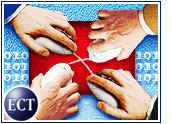
On the road to launching a new e-business Web site, all companies budget for obvious costs — planning, designing, registering and hosting the site — but if you are not careful, hidden expenses could overwhelm you on the journey. Would-be e-commerce site owners can avoid a lot of surprises by doing just a little bit of homework.
Of course, researching your options can prove to be a daunting task: A multitude of vendors and packages exist to choose among. However, if you sift through all the hype and stick to a well thought-out plan, you will find that creating an e-commerce Web site can be a manageable endeavor. The big question is: How much will it really cost to achieve your goal?
Take It to the Bank
For starters, because you are selling a product, you must have a merchant account to process customer credit cards. These accounts normally include setup costs, monthly charges and per-transaction costs. Marshall & Ilsley bank card relationship manager Devlin Norman told the E-Commerce Times that banks charge a flat fee for some services and percentages for others, while rates vary from one institution to another. He recommended investigating available offerings to determine exact expenses.
As an example, Norman outlined how an M&I merchant account generally works. First, there is a US$150 fee to set up an account with a year-long contract (although this cost shrinks to zero if you sign a four-year contract). Then there is a monthly account maintenance fee of $11.95 that includes 24-hour technical support. Another noteworthy expense is the flat $15 charge-back fee that occurs when a customer disputes a transaction.
But the biggest potential expense is the transaction fee — a 10-cent charge per transaction, plus 2.07 to 3.85 percent of the total amount of each transaction, depending on the amount of information transmitted. “You’ll have that cost every month, so the more transactions you process, the higher your fees are going to be,” Norman said.
Be Safe and Secure
In addition, if your Web site is going to accept credit card information from customers, you will need to use security protocols, which encrypt confidential data and reassure online customers that their personal information is safe. VeriSign is one company that sells security packages for e-merchants with different options and varying levels of protection.
An SSL Certificate is the most basic protection you will need to secure transaction information on your site. At VeriSign, 40-bit encryption costs $349 per year, while more secure 128-bit encryption costs $598 per year. You can get the SSL Certificate bundled in a professional package that also secures transaction data while it is being transmitted to your merchant account. This option costs $895 per year, with a more expanded package going for $1,395 per year.
Make Yourself Known
Marketing costs also play a vital role in drawing traffic once a site is live. The words “Internet marketing” may call to mind banners, pop-up ads, spam, customer lists and prime positioning in search engine results. But in today’s crowded market, it takes some savvy to figure out the best use for your advertising dollars.
Adam Weil, chief operating officer of Unreal Marketing Solutions, told the E-Commerce Times that newcomers to Internet advertising, or those with a limited marketing budget, should find a professional agency with expertise in the type of marketing that best suits their products and goals.
He added that there is more to determining the size of a marketing budget than simply deciding how much to spend to acquire and retain each new customer. “It also depends on what your business segment is,” he noted. “Are you B2B or B2C? The B2B market may be a little more difficult to reach and requires a larger investment and more testing. And how broad is your demographic? Is your item an impulse item? Do you have a lot of competition out there? What are you offering? All these things play a key role in how your product can be marketed.”
Weil said Unreal normally does not conduct Internet marketing campaigns that cost less than $5,000 to $10,000; on the other end of the spectrum, the company has clients that spend $1 million per month.
The High Cost of Maintenance
But maintenance costs likely will far exceed the other costs listed so far. For starters, Mary Kay Bowman, director of product marketing at Digital River, said fresh content is vital to keep online shoppers coming back. “In the offline world, you wouldn’t necessarily see the same items all the time displayed in a printed catalog,” she said. “Depending on who your customer base is, you may want to change your site daily. Freshness is a big issue that gets lost in the shuffle with maintenance.”
Bowman added that other costs may arise from customer transactions, such as fraud management, refunds and returns, and reconciliation with a merchant institution. Another expensive aspect of e-commerce, fulfillment, involves picking, packing and shipping purchased items as well as restocking returned items.
She noted that customers are accustomed to retail scenarios in which they can interact with another person, so it is also important that your company be available by e-mail and phone to handle returns and refunds or answer questions about ordering online.
Consider the Internals
Pindaro Demertzoglou, an adjunct professor at theLally School of Management at Rensselaer PolytechnicInstitute, said another important factor to consider is whether a new sales channel will negatively impact existing sales channels, resulting in cannibalization of a company’s own brick-and-mortar, mail order or phone sales.
Demertzoglou said companies also tend to underestimate how a new sales channel will affect their internal corporate processes in both the short and long term. “When you introduce new sales channels, new ways to do business, you must change your existing internal processes as well,” he said. “Otherwise, you’re just paving the cow path. You’re introducing new technology to do the same job that was there before.”
Additionally, companies often err in viewing their first e-commerce project as a finiteundertaking that begins on day one and ends on day 10. In reality, Demertzoglou said, once a corporation has created an e-commerce Web site, it usually begins to realize thepotential of the Internet and starts thinking about enhancing and expanding its Internet capabilities.
Measure ‘People Time’
Bowman also noted that when businesses estimate the internal costs of an e-commerce venture, there is often a perception, especially among small and mid-size businesses, that it will be less costly to develop and maintain an e-commerce initiative in-house because the required resources are already in place.
However, she said, companies often do not put enough value on “people time.” They assume that since they already have an internal process for their brick-and-mortar business, they will not have to account for the people time that the new e-commerce initiative will use. But people time is a cost, and companies must consider all the costs associated with changing their internal business processes.
Also, Bowman said, a strategic e-commerce plan should consider next steps. At what point in sales, fulfillment volume or accounting sophistication will a company need to create a separate department for its e-commerce initiative? When will it outgrow its in-house solution? These events should not come as surprises, but should be carefully anticipated in advance.
Develop a Plan
Therefore, Demertzoglou advises companies to create a strategic plan early in the planning process, with specific objectives drawn from a clear understanding of the required investment, expected return and anticipated long-term costs. He said most companies focus primarily on design, implementation and production of a Web site, then later are surprised by how much it costs to maintain once it is live.
He added that a good way to avoid hidden costs is to read case studies and executive summaries of other companies that have traveled down the e-commerce highway. He also recommends visiting Web sites, such as Microsoft’s bCentral.com, that provide tools, articles, advice, products and services for businesses planning to create an e-commerce presence.
“Get some real-world examples and see what other companies have faced,”Demertzoglou said, “and then you won’t find so many hidden surprises.”













































Fine to tell us about the hidden costs, but when you use Veri$$ign as the example for security certificates…. come on!
Please consider publishing a part 2 to this story where you give us the leaner, more effectively priced alternatives. People who don’t know any better will read this thinking it is the only way to go.
Well, yes, I guess it is. Bankrupt!